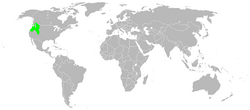Hobo Spider facts for kids
A Hobo Spider is a type of spider that belongs to a group called funnel-web spiders. They are known for their unique web shapes. These spiders can be found in different parts of the world, including North America, Europe, and Central Asia.
Quick facts for kids Hobo spider |
|
|---|---|
 |
|
| Hobo spider | |
| Scientific classification | |
| Kingdom: | |
| Phylum: | |
| Class: | |
| Order: | |
| Family: |
Agelenidae
|
| Genus: |
Tegenaria
|
| Species: |
T. agrestis
|
| Binomial name | |
| Tegenaria agrestis (Walckenaer, 1802)
|
|
 |
|
| Distribution in North America in green (native European distribution not shown) | |
Contents
What is a Hobo Spider?
The hobo spider, scientifically known as Tegenaria agrestis, is a spider that builds funnel-shaped webs. These webs are like a tunnel with a flat sheet of silk spreading out from one end. The spider waits inside the funnel for its prey. When an insect walks onto the web, the hobo spider quickly rushes out to catch it.
Where Do Hobo Spiders Live?
Hobo spiders are originally from Europe. Over time, they were accidentally brought to North America. They are now common in the Pacific Northwest region of the United States and parts of Canada. They prefer to live in places that are not disturbed often. This includes gardens, woodpiles, and sometimes even basements or garages in homes.
Appearance and Identification
Hobo spiders are medium-sized spiders. Their bodies are usually brown or grayish-brown. They have long, hairy legs. It can be tricky to tell them apart from other similar-looking spiders. Many spiders look alike, so it is best to be careful around any spider you do not recognize.
How Big Are They?
Female hobo spiders are usually a bit larger than males. A female's body can be about 11 to 15 millimeters long. Males are typically 8 to 11 millimeters long. Their legs can make them look much bigger.
Hobo Spider Bites
Hobo spiders are generally not aggressive. They usually only bite if they feel threatened or trapped. For example, if a spider is accidentally pressed against your skin, it might bite.
What Happens After a Bite?
A hobo spider bite might cause a red mark. Sometimes, it can lead to a blister. If you think you have been bitten by a spider, it is always a good idea to tell an adult. They can help you decide if you need to see a doctor. It is important to keep the bite area clean.
Life Cycle of a Hobo Spider
Hobo spiders go through several stages in their lives. Like all spiders, they start as eggs.
Eggs and Spiderlings
Female hobo spiders lay their eggs in a silk sac. This sac protects the eggs. After the eggs hatch, tiny spiderlings emerge. These young spiders are very small. They grow by shedding their outer skin, a process called molting.
Growing Up
As spiderlings grow, they molt several times. Each time they molt, they get a little bigger. They continue to grow until they reach their adult size. Adult hobo spiders usually live for about one year.
Funnel Webs
The web of a hobo spider is unique. It is shaped like a funnel or a cone. The spider builds this web in cracks or sheltered spots.
How the Web Works
The wide, flat part of the web acts like a tripwire. When an insect walks on it, the spider feels the vibrations. The spider then rushes out from the narrow end of the funnel. It quickly catches its prey and drags it back into the funnel to eat.
See also
 In Spanish: Araña vagabunda para niños
In Spanish: Araña vagabunda para niños

